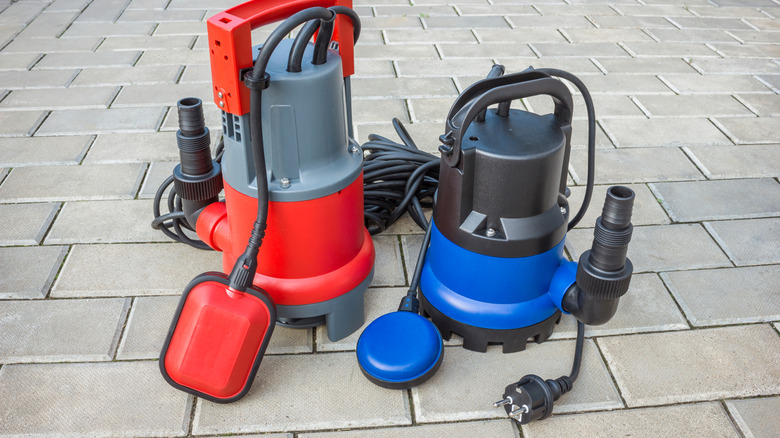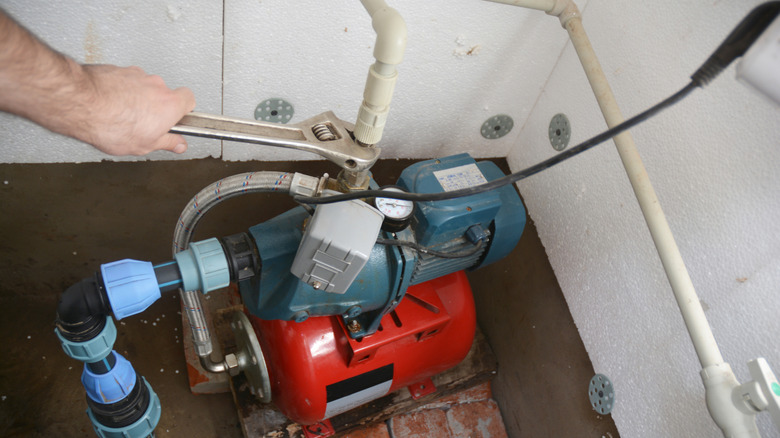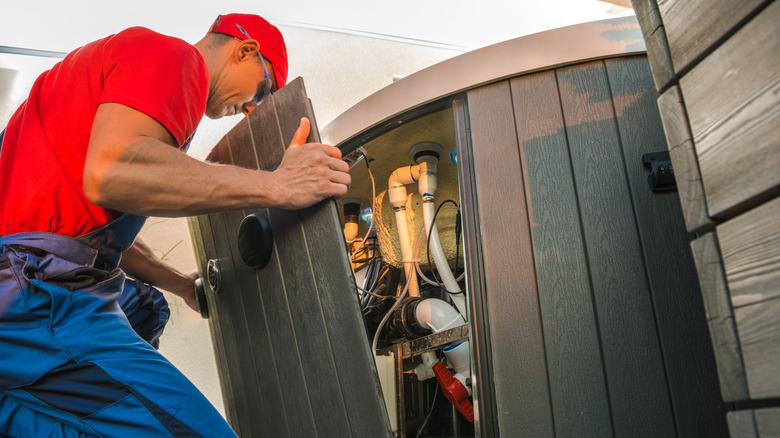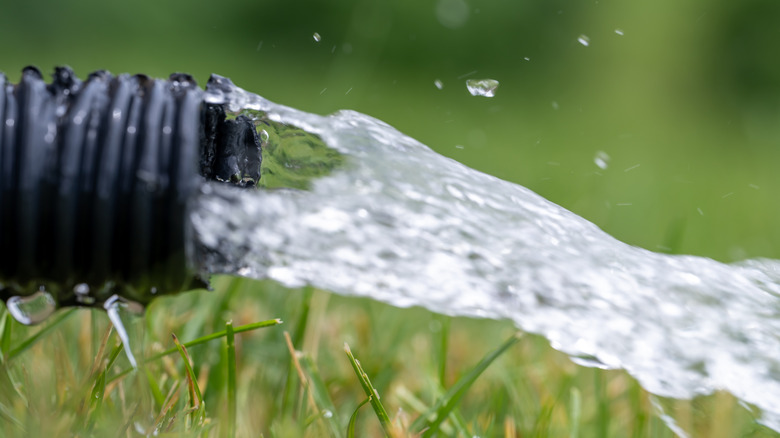Everything You Need To Know About Water Pumps For Your Home
We may receive a commission on purchases made from links.
There are a surprisingly small number of water pumps in the typical American home and, in fact, many houses don't have any pumps at all outside of appliances like dishwashers and washing machines. If you do have a water pump or two, odds are you really need it, so it's good to understand it and to take care of it. To that end, here's what you need to know about any pump that might help things flow smoothly in your home. And if you don't have any pumps, you probably should grab a submersible water pump for emergencies.
The pumps that are often described as "water pumps," are sometimes really, really not meant for drinking water at all. Household pumps (excluding things like fuel transfer pumps) can be designed to handle plain water, heavily amended "clean" water (with pool chemicals, for example), heavily amended "dirty" water (with laundry chemicals, for example), and various levels of solid contaminants that might be present in the water. These contaminants range from tiny food scraps to twigs to human waste.
Pumps are often designed with these variations in mind, and you'd generally be well-advised to pay attention to the limitations they imply. Putting even finely macerated leaf litter through a pump that's designed to deliver clear water to a sprinkler system, for example, can have catastrophic consequences ... especially if that pump is actually connected to sprinklers.
The types of water pumps in a home
Water pumps are often categorized by design (how a pump works) and by application (what it's installed to do). Pump design is usually not a super-important thing to worry about, unless you're buying or servicing a pump. Designs include open impeller, open vortex impeller, centrifugal, diaphragm, and many other bits of inscrutable jargon. What you're mostly interested in is probably the various applications of water pumps, and in spite of the fact that there are so few water pumps in our homes, there are certainly a lot of uses for them.
There are infrastructural pumps that are crucial to some home systems, such as pumps that boost water pressure, pool pumps, sewage pumps, well pumps, hot water recirculating pumps, and condensate pumps to remove water from air conditioning units. Some pumps are uncommon, but important nonetheless, like pumps that manage evaporative coolers and pumps that allow us to use gray water from sinks and bathtubs for reuse in landscapes.
And, of course, there are pumps that provide plain ol' water to our landscapes: lawn sprinkler, garden irrigation, and even fountain pumps. There are built-in pumps like sewage pumps to basement sump pumps for removing unwanted "water" on a regular basis, as well as utility transfer pumps of all sorts to move water around occasionally and wherever they're needed.
The important things to know about any pump
Whichever pumps you have in your house, or want to have, there are a few bits of information about these devices you need to be aware of, at least. It's a good idea to know where any pump is and, very generally, what it does. All of this leads to some specific information about individual pumps. First, of course, is understanding how critical the pump is to the functioning of your home. Well pumps and sewage pumps probably top the importance list, of course.
You should probably have a plan for when critical pumps fail, which entails understanding whether it will be needed during a power outage and, if so, whether it can operate on a power source other than mains electricity, such as battery backup. What size — that is, what capacity or pumping power — should your pumps be rated at, and why? Can it handle solids? Must it handle solids? It is submersible? Does it handle potable water? And, if it is a utility or transfer pump, does it require priming ... and do you know how to do that?
There's yet another tier of information you'll need to dig into if you plan to do any DIY installation or maintenance of pumps. What does the head pressure of your well pump need to be, for example? What is its power source (solar, gasoline, diesel, electric, natural gas, hydraulic, compressed air, or hand-powered), and how much power does the water pump consume? Because pumps are bought by type, these questions tend to revolve around capacity and power specs, and occasionally broad questions like whether your sump pump is submersible.
Sizing a pump properly
If you find yourself replacing a water pump or installing a new system that requires one, the key question you'll have to answer is about sizing. The size of a water pump is generally specified either by flow rate, usually in gallons per hour (gph) or gallons per minute (gpm), or as a power rating, usually in horsepower (hp). There are far too many variables to really generalize about pumps, or even to generalize about a specific type of pump.
A well pump, for example, must be sized taking into account the depth of the well, the size of your pressure tank, the refresh rate (that is, the supply capacity) of the well, and the needs of the home in terms of the number of sinks, baths/showers, dishwashers, occupants, and the like. You'll also want to know a bit about the proclivities of the inhabitants; an avid gardener might require more capacity, for example. Capacity tends to be expressed in gpm, which you might need to translate into a required horsepower rating. Typical pumps range in horsepower from ½ hp to 20 hp or even more.
An undersized well pump might produce too little water for the household, or might not be able to lift the water far enough to supply the house at all. Replacing a well pump with an oversized model is preferable to undersizing it, but when your pump outstrips the well's ability to supply water you'll need a low-water pump protection system that keeps the pump from running dry, which can damage water pumps. In some other applications, an oversized pump can also lead to constant cycling, which can burn out the pump.
Dealing with pump emergencies
Water pumps have the weird ability to both create emergencies and to alleviate them, even in situations where a pump was not involved before. For example, it is forever and always an emergency when your well pump stops cooperating, and DIY well pump repair might prove to be a valuable skill. For those without a well, when the power goes out, the water often doesn't (unless the homeowner has some filtering mechanism that requires power and can't be bypassed).
Understanding your critical pumps will make emergencies far more manageable. Simply knowing the whereabouts of a septic system or sewage ejector pump (if you have one) is the first step toward replacing it in an emergency, and you'll figure the rest out pretty easily when your septic service tells you about their four-week waiting list. It helps to be able to at least replace, or perhaps even repair, the most important pumps. This isn't as scary as it sounds; replacing a damaged impeller is usually a trivial task. Which is good, because problems arise more often than you'd expect.
For example, wastewater systems can only handle solids of a certain size, and this is especially true when effluent pumps are involved. The first time a homeowner has to disentangle a Hot Wheels car or an inexplicably flushed chunk of steak from a sewage pump's impeller or check valve, there will be grumbling. The second time, there might be colorful language and threats about gluing toilet seats closed.
Pumps to deal with other emergencies... and everyday life
On the other hand, there are emergencies that the right pump can simply fix, and it's probably a good idea to think through the possibilities and make sure you have some appropriate pump(s) on hand. The most obvious is a flooding situation. For a home with a sump pump, the solution is built in. But if you get surprise flooding, it might do irreparable damage to your home or your property before you can even figure out where to get a pump. And weather-related flooding won't just happen to you alone, so don't wait until the emergency is happening to buy a pump. They'll probably be sold out.
Or perhaps your emergency is getting water to a garden, or to the livestock on a homestead. Those are clearly emergencies; that's your food. Having a good transfer pump on hand can eliminate all but the most dire of emergencies and, in fact, you should consider two: a small utility pump like a 10 HP transfer pump, which provides up to 330 gph; and a larger pump, depending on your situation. A big pump like the gas-powered, 6.5-hp Bilt Hard semi-trash pump moves a staggering 158 gpm through its 2-inch water lines, and can save your home's foundation. Again, ask us how we know. And, of course, you will occasionally need a pump even without the emergency, such as when draining a pool or pushing rain barrel water to a sprinkler system.





